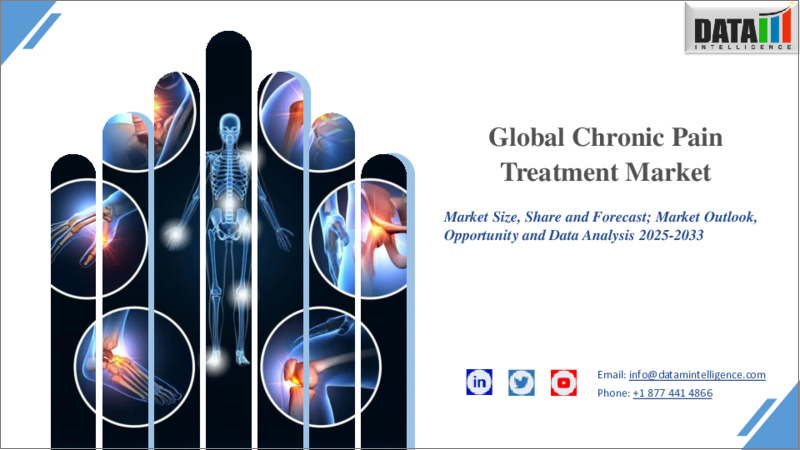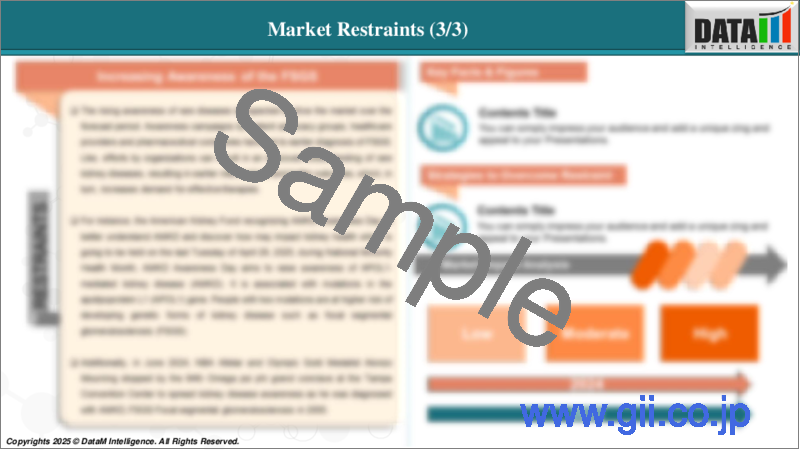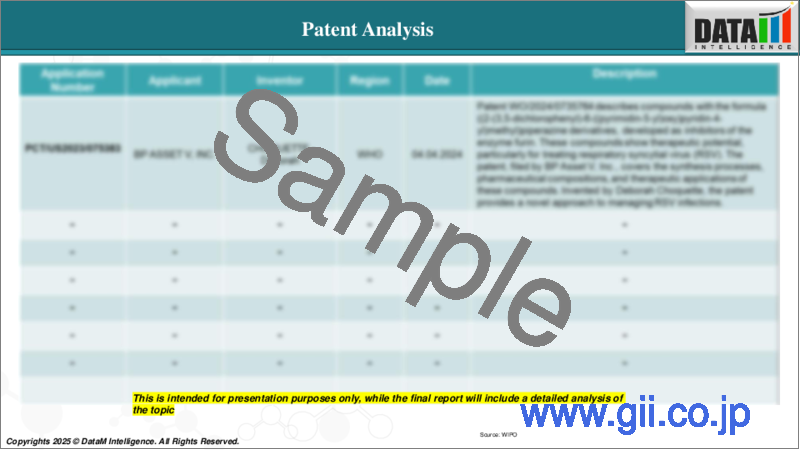|
|
市場調査レポート
商品コード
1319137
慢性疼痛治療の世界市場-2023年~2030年Global Chronic Pain Treatment Market - 2023-2030 |
||||||
カスタマイズ可能
適宜更新あり
|
|||||||
| 慢性疼痛治療の世界市場-2023年~2030年 |
|
出版日: 2023年07月31日
発行: DataM Intelligence
ページ情報: 英文 195 Pages
納期: 即日から翌営業日
|
- 全表示
- 概要
- 目次
市場概要
慢性疼痛治療の世界市場は、2022年に838億米ドルに達し、2023-2030年の予測期間中にCAGR 7.1%で成長し、2030年には1,432億米ドルに達すると予測されています。慢性疼痛を効果的かつ安全に管理するために、高周波技術、再生生体材料、多血小板血漿、間葉系幹細胞などの新しい戦略が進化してきました。これらは、慢性疼痛の治療に使用される今後の処置の一部です。
慢性疼痛は、痛みが数ヶ月から数年にわたり持続する主要な健康状態です。慢性疼痛は主に、糖尿病、線維筋痛症、重度の腰痛を患っている人に影響を及ぼします。若いうちから積極的に運動することで、慢性疼痛を抑えることができます。痛みがひどい場合は、鎮痛剤を服用することもできます。
オピオイド、非ステロイド性抗炎症薬(NSAIDs)、抗けいれん薬、抗うつ薬などが、慢性疼痛の治療によく使われる薬です。神経刺激デバイスや鎮痛剤注入は、慢性疼痛を治療するための最も一般的に使用される装置です。さらに、慢性疾患の有病率の増加、老年人口の増加、技術的進歩、臨床試験の増加、FDA認可の増加といった重要な成長促進要因が、将来の市場成長をもたらしています。
市場力学
老年人口の増加が世界の慢性疼痛治療市場の成長を牽引
高齢者人口の増加は、慢性疼痛治療市場の主要な成長要因です。老年人口は、関節炎、がん、慢性腰痛、神経障害性疼痛などの慢性疼痛疾患に罹患しやすいです。例えば、ncbi.nih.govによると、2022年9月22日に発表された「multidisciplinary management of chronic pain in elderly oncology patients」という論文によると、慢性疼痛はがん患者における最も一般的で最も厄介な症状の一つであり、高齢者層で頻繁に発生すると述べられています。
がん患者における疼痛は、腫瘍組織の成長による細胞、組織、全身の変化や、進行性の衰弱性疾患に伴う変化など、複雑な病理学的メカニズムから生じる。慢性疼痛は、がん治療やブレークスルーペインによって直接引き起こされることもあります。特に高齢者に多い神経障害性疼痛の患者は、皮膚表面の特定部位の灼熱感、ピリピリ感、しびれ感を訴え、手足に沿って突然、身を引き裂かれるような痛みが襲ってくる。
慢性疼痛治療機器の技術進歩が今後の市場成長を後押し
慢性疼痛治療市場は、様々な技術の進歩により大きな成長を遂げています。多くの主要企業が新製品やサービスを発表することで、こうした進歩に大きな役割を果たしています。この新製品は、慢性疾患に苦しむ患者の生産性と有効性を高めることができます。
例えば、2023年5月16日、Abbotは脊髄刺激(SCS)装置が米国食品医薬品局から承認されたと発表しました。このSCS装置は慢性腰痛の治療に使用されます。主に、手術による腰痛の治療を行っていない、あるいは行う資格がない人々に利用されています。この表示拡大は、Abbot独自のBurstDR SCS技術が、慢性腰痛患者の疼痛レベル、日常活動能力、感情的幸福を改善することを実証した、明確な研究結果によって裏付けられました。
慢性関節痛が抱える重大な課題が世界の慢性疼痛治療市場を阻害する見込み
2022年7月7日に出版されたEveryday Healthの「The Risks of Untreated Rheumatoid Arthritis」によると、関節炎を治療せずに放置すると、関節痛のような合併症を引き起こす可能性があります。関節炎患者が心臓病になるリスクは高いです。この炎症は血管を狭くし、プラークを蓄積させます。
Arthritis & Rheumatologyで2022年5月に発表された研究によると、関節リウマチと心臓の問題の間のリンクは、高血圧、高コレステロール、喫煙、糖尿病、および座りがちであることのような心臓病の危険因子を監視し、管理することの重要性を増加させます。全体的に、関節炎が進行すればするほど、心臓障害のリスクは高くなります。
COVID-19影響分析
COVID-19の大流行は慢性疼痛治療薬市場に大きな影響を与えました。パンデミックの最盛期には、多くの医療システムが圧倒され、緊急性のない医療処置やスクリーニングは延期または中止されました。そのため、慢性疼痛疾患の診断や患者の治療開始が遅れました。その結果、慢性疼痛症例の中には診断が遅れ、治療成績に影響を及ぼす可能性があっています。
また、COVID-19感染のリスクを最小限に抑えるため、医療プロバイダーは、対面診療の削減、遠隔診療の増加、治療スケジュールの変更など、治療提供における変更を実施しました。こうした変化は、患者の全体的な経験や慢性疼痛治療の管理に影響を与えています。したがって、上記の要因により、慢性疼痛治療市場は予測期間中、中程度の影響を受けると予想されます。
ロシア・ウクライナ紛争分析
ロシアとウクライナの紛争は、医療や、関節炎や慢性腰痛などの慢性疼痛疾患の管理を含め、両国の生活の様々な側面に重大な影響を及ぼしています。紛争は、影響を受けた地域の医療インフラの破壊と混乱につながっています。病院や診療所などの医療施設が被害を受けたり、アクセスできなくなったりすることで、慢性疼痛疾患の患者が適切な診断、治療、フォローアップケアを受けることが難しくなる可能性があります。
紛争の結果、医療機器、医薬品、専門的な医療専門家などの医療資源の入手が制限されることもあります。この不足は、慢性疼痛疾患患者の診断の遅れ、不十分な治療選択肢、最適とは言えない疾患管理につながっています。
紛争は人口の移動をもたらし、人々は家を離れ、安全な地域に避難することを余儀なくされています。このような人口移動は患者のケアの継続性を妨げ、慢性疼痛障害の治療を中断させる可能性があります。
目次
第1章 調査手法と調査範囲
第2章 定義と概要
第3章 エグゼクティブサマリー
第4章 市場力学
- 影響要因
- 促進要因
- 老年人口の増加が市場成長を牽引
- 慢性疼痛治療デバイスの技術的進歩
- 抑制要因
- 慢性関節痛が抱える大きな課題
- 機会
- 慢性疼痛治療デバイスの新興市場
- 影響分析
- 促進要因
第5章 産業分析
- ポーターの5フォース分析
- サプライチェーン分析
- アンメットニーズ
- 規制分析
第6章 COVID-19分析
第7章 ロシア・ウクライナ戦争分析
第8章 適応症別
- 神経障害性疼痛
- 鎮痛薬注入
- アブレーション
第9章 製品タイプ別
- 薬剤
- オピオイド
- 非ステロイド性抗炎症薬
- 抗けいれん薬
- 抗うつ薬
- その他
- デバイス
- 神経刺激デバイス
- 鎮痛剤注入
- アブレーション
第10章 流通チャネル別
- 病院
- クリニック
- 外来センター
第11章 地域別
- 北米
- 米国
- カナダ
- メキシコ
- 欧州
- ドイツ
- 英国
- フランス
- イタリア
- スペイン
- その他欧州
- 南米
- ブラジル
- アルゼンチン
- その他南米
- アジア太平洋
- 中国
- インド
- 日本
- オーストラリア
- その他アジア太平洋地域
- 中東およびアフリカ
第12章 競合情勢
- 競合シナリオ
- 製品ベンチマーク
- 企業シェア分析
- 主な発展と戦略
第13章 企業プロファイル
- Pfizer Inc.
- 会社概要
- 製品ポートフォリオと説明
- 財務概要
- 主な発展
- Abbott Laboratories
- Eli Lilly and Company
- Novartis AG
- Johnson & Johnson
- Sanofi SA
- Teva Pharmaceutical Industries Ltd
- Baxter International
- Merck & Co. Inc
- Boston Scientific Corporation
第14章 付録
Market Overview
Global Chronic Pain Treatment Market reached US$ 83.8 billion in 2022 and is expected to reach US$ 143.2 billion by 2030 growing with a CAGR of 7.1% during the forecast period 2023-2030. Novel strategies have evolved for the effective and safe management of chronic pain such as Radiofrequency technique, regenerative biomaterial, platelet-rich plasma, and mesenchymal stem cells; are some of the upcoming procedures that are used in chronic pain treatments.
Chronic pain is a major health condition where the pain lasts for months or years. Chronic pain mainly affects people who are already suffering from diabetes, fibromyalgia, and severe back pains. Being active and doing exercise at a younger age can control chronic pains. Pain medications can be taken by a patient if it is in a severe case.
Opioids, non-steroidal anti-inflammatory drugs(NSAIDs), anticonvulsants, and antidepressants are the most commonly used drugs for treating chronic pain. Neurostimulation devices and analgesic infusions are the most commonly used devices for treating chronic pain. Furthermore, significant growth drivers such as the increasing prevalence of chronic diseases, growing geriatric population, technical advancements, rising clinical trials, and increasing FDA approvals give rise to future market growth.
Market Dynamics
Increasing Geriatric Population Drives the Growth of the Global Chronic Pain Treatment Market Growth
The rising population of elderly and old people is a major growth factor in the chronic pain treatment market. The geriatric population is more prone to chronic pain disorders like arthritis, cancers, chronic back pain and neuropathic pains. For instance, according to ncbi.nih.gov, an article entitled multidisciplinary management of chronic pain in elderly oncology patients published on Sep 22 2022, states that chronic pain is one of the most common and most bothersome symptoms in cancer patients, which occurs often in the elderly population.
Pain in cancer patients results from complex pathological mechanisms, including cellular, tissue, and systemic changes caused by growing tumor tissue, as well as changes associated with a progressive, debilitating disease. Chronic pain can be caused directly by cancer treatment and breakthrough pains. Patients with neuropathic pain, which is especially frequent in elderly individuals complain about the burning, tingling, or numbness in a specific area of the skin surface with attacks of sudden and wrenching pain along the limb.
Technical Advancement of the Chronic Pain Devices is Boosting the Future Market Growth
The chronic pain treatment market has witnessed significant growth due to various technological advancements. Many key players play a major role in these advancements by launching new products and services. This new product can rise the productivity and efficacy of patients who suffered from chronic illness.
For instance, on May 16, 2023, Abbot announced that its spinal cord stimulation (SCS) devices has approved by the U.S Food and Drug Administration. This SCS device is used for the treatment of chronic back pain. It is mainly utilized by people who have not or not eligible to perform surgical back pain. This labeling expansion was supported by results from the distinct study, which demonstrated that Abbott's proprietary BurstDR SCS technology improved pain levels, ability to perform daily activities, and emotional well-being in people with chronic back pain.
Significant Challenges Possessed with Chronic Arthritis Pain are Expected to Hamper Global Chronic Pain Treatment Market
According to Everyday Health journal, a journal entitled The Risks of Untreated Rheumatoid Arthritis published on July 7, 2022, if the arthritis is left untreated, then it may cause complications like joint pains. There is a high risk of getting heart disease for arthritis patients. This inflammation can also contribute to the narrowing of your blood vessels which allows plaque to build up.
According to a study published in May 2022 in Arthritis & Rheumatology, the link between Rheumatoid arthritis and heart problems increases the importance of monitoring and managing heart disease risk factors such as high blood pressure, high cholesterol, smoking, diabetes, and being sedentary. Overall, the more advanced your arthritis, the greater risk for heart damage.
COVID-19 Impact Analysis
The COVID-19 pandemic has had a significant impact on the chronic pain treatment market. During the height of the pandemic, many healthcare systems were overwhelmed, and non-urgent medical procedures and screenings were postponed or canceled. This led to delays in the diagnosis of chronic pain disorders and initiation of treatment for patients. As a result, some chronic pain cases may have been diagnosed at later stages, potentially affecting treatment outcomes.
Also, to minimize the risk of COVID-19 transmission, healthcare providers implemented changes in treatment delivery, such as reducing in-person clinic visits, increasing telemedicine consultations, and modifying treatment schedules. These changes have impacted the overall patient experience and the management of chronic pain treatment. Therefore, owing to the above factors, the chronic pain treatment market is expected to be moderately affected over the forecast period.
Russia-Ukraine Conflict Analysis
The Russia-Ukraine conflict has had significant implications for various aspects of life in both countries, including healthcare and the management of chronic pain diseases such as arthritis and chronic back pain. The conflict has led to the destruction and disruption of healthcare infrastructure in affected regions. Medical facilities, including hospitals and clinics, may be damaged or inaccessible, making it challenging for patients with chronic pain diseases to receive proper diagnosis, treatment, and follow-up care.
The conflict can result in limited availability of medical resources, including medical devices, medications, and specialized healthcare professionals. This scarcity led to delays in diagnosis, inadequate treatment options, and suboptimal disease management for chronic pain disorders patients.
The conflict has resulted in population displacement, with people forced to leave their homes and seek refuge in safer areas. This displacement can disrupt patients' continuity of care, as they may have difficulty accessing their regular healthcare providers and treatment facilities, potentially leading to interruptions in their chronic pain disorder treatment.
Segment Analysis
The global chronic pain treatment market is segmented based on product type, indication, distribution channel, and region.
Owing to the Increasing Prevalence of Chronic Diseases like Migraines, Rising Clinical Trials, the Drug Segment Accounted for Approximately 42.3% of the Chronic Pain Treatment Market Share
Some medications commonly prescribed to manage depression and prevent epileptic seizures have been found to help relieve chronic pain. This is true especially for chronic nerve pain. They help relieve back pain, fibromyalgia and diabetes-related nerve pain, known as diabetic neuropathy. Because chronic pain often worsens depression, antidepressants offer the extra benefit of treating mood symptoms.
For instance, on Feb 27, 2023, Scilex Holding Company announced the commercial launch of an oral solution ELYXYBTM in the U.S., strengthening its leadership position in non-opioid pain management. ELYXYBTM is a first-line treatment and the only FDA-approved, ready-to-use oral solution for the acute treatment of migraine. There is strong evidence for the use of NSAIDs as a first-line treatment for migraine. Celecoxib is in the same class of agents which is fast acting, and has the potential to have the lowest side effects of all NSAIDs.
Geographical Analysis
North America Accounted for Approximately 39.6% of the Market Share in 2022, Owing to the Increasing Research and Development Activities and Well-Established Healthcare Infrastructure
The North American region is anticipated to experience growth in the field of chronic pain treatments due to factors such as rising research and development efforts, a robust healthcare infrastructure, and supportive reimbursement systems.
These factors contribute to increased accessibility for patients to access advanced therapies, facilitating the adoption of cutting-edge treatments. This trend is expected to drive the North American region's progress in chronic pain treatment throughout the forecast period.
For instance, On Oct 14, 2022, Nevro Corporation announced that the Senza HFX iQ spinal cord stimulation system has received approval from U.S FDA. The company further decides a limited release of Senza HFX iQ in the quarter. Additionally, US FDA approval for HFX iQ, Nevro has submitted the technology for approval in Europe too. The system is comprised of the HFX iQ implantable pulse generator (IPG), HFX trial stimulator, charger and HFX app, and will launch with algorithms specifically for treating chronic back and leg pain, including non-surgical back pain (NSBP) and painful diabetic neuropathy (PDN).
Competitive Landscape
The major global players in the market include: Pfizer Inc., Abbott Laboratories, Eli Lilly and Company, Novartis AG, Johnson & Johnson, Sanofi SA, Teva Pharmaceutical Industries Ltd, Baxter International, Merck & Co. Inc, Boston Scientific Corporation
Why Purchase the Report?
- To visualize the global chronic pain treatment market segmentation based on the product type, indication, distribution channel, and region as well as understand key commercial assets and players.
- Identify commercial opportunities by analyzing trends and co-development.
- Excel data sheet with numerous data points of chronic pain treatment market-level with all segments.
- PDF report consists of a comprehensive analysis after exhaustive qualitative interviews and an in-depth study.
- Product mapping available as excel consisting of key products of all the major players.
The global chronic pain treatment market report would provide approximately 69 tables, 70 figures, and 195 Pages.
Target Audience 2023
- Manufacturers/ Buyers
- Industry Investors/Investment Bankers
- Research Professionals
- Emerging Companies
Table of Contents
1. Methodology and Scope
- 1.1. Research Methodology
- 1.2. Research Objective and Scope of the Report
2. Definition and Overview
3. Executive Summary
- 3.1. Snippet by Product Type
- 3.2. Snippet by Indication
- 3.3. Snippet by Distribution Channel
- 3.4. Snippet by Region
4. Dynamics
- 4.1. Impacting Factors
- 4.1.1. Drivers
- 4.1.1.1. Increasing Geriatric Population Drives Market Growth
- 4.1.1.2. Technical Advancement of the Chronic Pain Device
- 4.1.2. Restraints
- 4.1.2.1. Significant Challenges Possessed with Chronic Arthritis Pain
- 4.1.3. Opportunity
- 4.1.3.1. Emerging Markets of Chronic Pain Treatment Devices
- 4.1.4. Impact Analysis
- 4.1.1. Drivers
5. Industry Analysis
- 5.1. Porter's 5 Forces Analysis
- 5.2. Supply Chain Analysis
- 5.3. Unmet Needs
- 5.4. Regulatory Analysis
6. COVID-19 Analysis
- 6.1. Analysis of COVID-19
- 6.1.1. Scenario Before COVID-19
- 6.1.2. Scenario During COVID-19
- 6.1.3. Scenario Post COVID-19
- 6.2. Pricing Dynamics Amid COVID-19
- 6.3. Demand-Supply Spectrum
- 6.4. Government Initiatives Related to the Market During the Pandemic
- 6.5. Manufacturers' Strategic Initiatives
- 6.6. Conclusion
7. Russia-Ukraine War Analysis
8. By Indication
- 8.1. Introduction
- 8.1.1. Market Size Analysis and Y-o-Y Growth Analysis (%), By Indication
- 8.1.2. Market Attractiveness Index, By Indication
- 8.2. Neuropathic Pain*
- 8.2.1. Introduction
- 8.2.2. Market Size Analysis and Y-o-Y Growth Analysis (%)
- 8.3. Analgesic Infusion
- 8.4. Ablation
9. By Product Type
- 9.1. Introduction
- 9.1.1. Market Size Analysis and Y-o-Y Growth Analysis (%), By Product Type
- 9.1.2. Market Attractiveness Index, By Product Type
- 9.2. Drugs*
- 9.2.1. Introduction
- 9.2.2. Market Size Analysis and Y-o-Y Growth Analysis (%)
- 9.2.3. Opioids
- 9.2.4. NSAIDs
- 9.2.5. Anticonvulsants
- 9.2.6. Antidepressants
- 9.2.7. Others
- 9.3. Devices
- 9.3.1. Neurostimulator Device
- 9.3.2. Analgesic Infusion
- 9.3.3. Ablation
10. By Distribution Channel
- 10.1.1. Market Size Analysis and Y-o-Y Growth Analysis (%), By Distribution Channel
- 10.1.2. Market Attractiveness Index, By Distribution Channel
- 10.2. Hospital
- 10.2.1. Introduction
- 10.2.2. Market Size Analysis and Y-o-Y Growth Analysis (%)
- 10.3. Clinics
- 10.4. Ambulatory Centers
11. By Region
- 11.1. Introduction
- 11.1.1. Market Size Analysis and Y-o-Y Growth Analysis (%), By Region
- 11.1.2. Market Attractiveness Index, By Region
- 11.2. North America
- 11.2.1. Introduction
- 11.2.2. Key Region-Specific Dynamics
- 11.2.3. Market Size Analysis, and Y-o-Y Growth Analysis (%), By Product Type
- 11.2.4. Market Size Analysis, and Y-o-Y Growth Analysis (%), By Indication
- 11.2.5. Market Size Analysis, and Y-o-Y Growth Analysis (%), By Distribution Channel
- 11.2.6. Market Size Analysis, and Y-o-Y Growth Analysis (%), By Country
- 11.2.6.1. U.S.
- 11.2.6.2. Canada
- 11.2.6.3. Mexico
- 11.3. Europe
- 11.3.1. Introduction
- 11.3.2. Key Region-Specific Dynamics
- 11.3.3. Market Size Analysis, and Y-o-Y Growth Analysis (%), By Product Type
- 11.3.4. Market Size Analysis, and Y-o-Y Growth Analysis (%), By Indication
- 11.3.5. Market Size Analysis, and Y-o-Y Growth Analysis (%), By Distribution Channel
- 11.3.6. Market Size Analysis, and Y-o-Y Growth Analysis (%), By Country
- 11.3.6.1. Germany
- 11.3.6.2. U.K.
- 11.3.6.3. France
- 11.3.6.4. Italy
- 11.3.6.5. Spain
- 11.3.6.6. Rest of Europe
- 11.4. South America
- 11.4.1. Introduction
- 11.4.2. Key Region-Specific Dynamics
- 11.4.3. Market Size Analysis, and Y-o-Y Growth Analysis (%), By Product Type
- 11.4.4. Market Size Analysis, and Y-o-Y Growth Analysis (%), By Indication
- 11.4.5. Market Size Analysis, and Y-o-Y Growth Analysis (%), By Distribution Channel
- 11.4.6. Market Size Analysis, and Y-o-Y Growth Analysis (%), By Country
- 11.4.6.1. Brazil
- 11.4.6.2. Argentina
- 11.4.6.3. Rest of South America
- 11.5. Asia Pacific
- 11.5.1. Introduction
- 11.5.2. Key Region-Specific Dynamics
- 11.5.3. Market Size Analysis, and Y-o-Y Growth Analysis (%), By Product Type
- 11.5.4. Market Size Analysis, and Y-o-Y Growth Analysis (%), By Indication
- 11.5.5. Market Size Analysis, and Y-o-Y Growth Analysis (%), By Distribution Channel
- 11.5.6. Market Size Analysis, and Y-o-Y Growth Analysis (%), By Country
- 11.5.6.1. China
- 11.5.6.2. India
- 11.5.6.3. Japan
- 11.5.6.4. Australia
- 11.5.6.5. Rest of Asia Pacific
- 11.6. Middle East and Africa
- 11.6.1. Introduction
- 11.6.2. Key Region-Specific Dynamics
- 11.6.3. Market Size Analysis, and Y-o-Y Growth Analysis (%), By Product Type
- 11.6.4. Market Size Analysis, and Y-o-Y Growth Analysis (%), By Indication
- 11.6.5. Market Size Analysis, and Y-o-Y Growth Analysis (%), By Distribution Channel
12. Competitive Landscape
- 12.1. Competitive Scenario
- 12.2. Product Benchmarking
- 12.3. Company Share Analysis
- 12.4. Key Developments and Strategies
13. Company Profiles
- 13.1. Pfizer Inc. *
- 13.1.1. Company Overview
- 13.1.2. Product Portfolio and Description
- 13.1.3. Financial Overview
- 13.1.4. Key Developments
- 13.2. Abbott Laboratories
- 13.3. Eli Lilly and Company
- 13.4. Novartis AG
- 13.5. Johnson & Johnson
- 13.6. Sanofi SA
- 13.7. Teva Pharmaceutical Industries Ltd
- 13.8. Baxter International
- 13.9. Merck & Co. Inc
- 13.10. Boston Scientific Corporation
LIST NOT EXHAUSTIVE
14. Appendix
- 14.1. About Us and Services
- 14.2. Contact Us






